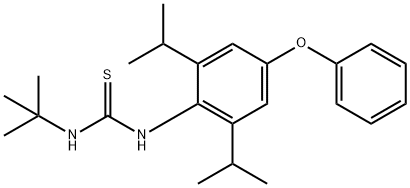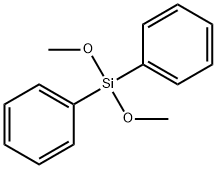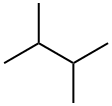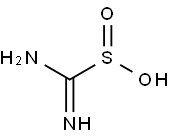Diafenthiuron
- CAS NO.:80060-09-9
- Empirical Formula: C23H32N2OS
- Molecular Weight: 384.58
- MDL number: MFCD01311814
- SAFETY DATA SHEET (SDS)
- Update Date: 2024-12-18 14:15:30

What is Diafenthiuron?
Description
Diafenthiuron is a broad spectrum acaricide and insecticide, diafenthiuron is registered for use on cotton, soybeans, vegetables, fruit and ornamentals. It controls all post-hatch stages of mites, whiteflies and aphids. Its ability to control all sucking pests of cotton as well as mites, with no known toxicity to beneficial insects, is unique and very valuable in cotton integrated pest management (IPM) programs.
The Uses of Diafenthiuron
Diafenthiuron is an insecticide.
Definition
ChEBI: Diafenthiuron is an aromatic ether that is 1,3-diisopropyl-5-phenoxybenzene in which the hydrogen atom at position 2 is substituted by a (tert-butylcarbamothioyl)nitrilo group. An agricultural proinsecticide which is used to control mites, aphids and whitefly in cotton. It has a role as an oxidative phosphorylation inhibitor and a proinsecticide. It is a thiourea acaricide, a thiourea insecticide and an aromatic ether. It is functionally related to a diphenyl ether.
Toxicology
Diafenthiuron has low toxicity to birds, mammals and beneficial insects, and is only slightly toxic to predatory mites. It is toxic to fish, but presents little hazard because it is rapidly degraded.
Mode of action
Diafenthiuron is a proinsecticide, which means that it must be converted to another compound – the drug – in order to be toxic. Activation of diafenthiuron to its carbodiimide drug occurs on the leaf surface, catalyzed by light, or in the insect, catalyzed by P450 monooxygenases. Diafenthiuron carbodiimide binds to the glutamate residue in the transmembrane F0 subunit of ATP synthase where protons from the intermembrane space dock to begin their journey across the inner mitochondrial membrane. Binding of diafenthiuron carbodiimide to this site blocks proton transport and ATP synthesis. Diafenthiuron was launched in 1991 and resistance has not yet been reported.
Properties of Diafenthiuron
| Melting point: | 144.6-147.7°C |
| Boiling point: | 448.8±55.0 °C(Predicted) |
| Density | 1.0367 (rough estimate) |
| refractive index | 1.5950 (estimate) |
| Flash point: | 149 °C |
| storage temp. | 0-6°C |
| solubility | Chloroform (Slightly), Methanol (Slightly) |
| form | neat |
| pka | 12?+-.0.70(Predicted) |
| form | Solid |
| color | White to Off-White |
| Water Solubility | Water: < 0.1 mg/mL (insoluble) |
| Merck | 13,2988 |
| BRN | 8343025 |
| CAS DataBase Reference | 80060-09-9(CAS DataBase Reference) |
| EPA Substance Registry System | Diafenthiuron (80060-09-9) |
Safety information for Diafenthiuron
| Signal word | Warning |
| Pictogram(s) |
 Exclamation Mark Irritant GHS07 |
| GHS Hazard Statements |
H332:Acute toxicity,inhalation |
| Precautionary Statement Codes |
P261:Avoid breathing dust/fume/gas/mist/vapours/spray. P271:Use only outdoors or in a well-ventilated area. |
Computed Descriptors for Diafenthiuron
Diafenthiuron manufacturer
India Pesticides Limited
ENTOMIC CHEMICALS
HPM Chemicals And Fertilizers Ltd
Aimco Pesticides Limited
New Products
(S)-3-Aminobutanenitrile hydrochloride 4-Methylphenylacetic acid N-Boc-D-alaninol N-BOC-D/L-ALANINOL Tert-butyl bis(2-chloroethyl)carbamate 3-Morpholino-1-(4-nitrophenyl)-5,6-dihydropyridin- 2(1H)-one Furan-2,5-Dicarboxylic Acid Tropic acid 1-Bromo-3,5-Di-Tert-Butylbenzene S-2-CHLORO PROPIONIC ACID ETHYL ISOCYANOACETATE 2-Bromo-1,3-Bis(Dimethylamino)Trimethinium Hexafluorophosphate 4-IODO BENZOIC ACID 3-NITRO-2-METHYL ANILINE 1-(2,4-DICHLOROPHENYL) ETHANAMINE (2-Hydroxyphenyl)acetonitrile 4-Bromopyrazole 2-(Cyanocyclohexyl)acetic acid 4-methoxy-3,5-dinitropyridine 1-(4-(aminomethyl)benzyl)urea hydrochloride 2-aminopropyl benzoate hydrochloride diethyl 2-(2-((tertbutoxycarbonyl)amino) ethyl)malonate tert-butyl 4- (ureidomethyl)benzylcarbamate Ethyl-2-chloro((4-methoxyphenyl)hydrazono)acetateRelated products of tetrahydrofuran








You may like
-
 80060-09-9 Diafenthiuron 99%View Details
80060-09-9 Diafenthiuron 99%View Details
80060-09-9 -
 80060-09-9 99%View Details
80060-09-9 99%View Details
80060-09-9 -
 80060-09-9 Diafenthiuron 98%View Details
80060-09-9 Diafenthiuron 98%View Details
80060-09-9 -
 80060-09-9 98%View Details
80060-09-9 98%View Details
80060-09-9 -
 Diafenthiuron 98%View Details
Diafenthiuron 98%View Details
80060-09-9 -
 Diafenthiuron 80060-09-9 99%View Details
Diafenthiuron 80060-09-9 99%View Details
80060-09-9 -
 Diafenthiuron CAS 80060-09-9View Details
Diafenthiuron CAS 80060-09-9View Details
80060-09-9 -
 Diafenthiuron CAS 80060-09-9View Details
Diafenthiuron CAS 80060-09-9View Details
80060-09-9